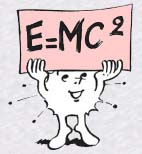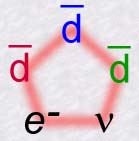Towards Grand Unification
or
More than 3 or 2 interactions...
or
More than 3 or 2 interactions...
![]() Philosophy
and physicists dreams of unification.
Philosophy
and physicists dreams of unification.
 Physicists have
a secret dream: To be able to explain all phenomena in the Universe with
the minimum number of elements: Reduce the number of particles (see the
supercords theory) and the number of interactions to one. This quest, is
it utopian or realisable?
Physicists have
a secret dream: To be able to explain all phenomena in the Universe with
the minimum number of elements: Reduce the number of particles (see the
supercords theory) and the number of interactions to one. This quest, is
it utopian or realisable?
![]() The
same evolution has occured concerning the forces which govern our Universe:
The
same evolution has occured concerning the forces which govern our Universe:
This evolution towards the unification of forces may actually come to be understood following two different approaches:
![]()
Our Standard Model finally describes only 4 interactions?
False. In reality, and since 1967, the weak and
electromagnetic interactions have been unified by the theory of the
electroweak interaction.
In 1979, two American physicists (Sheldon Lee Glashow and Steven Weinberg) and a pakistani physicist (Abdus Salam) received the Nobel Physics Prize for their theoretical work which in 1967 unified the weak and electromagnetic interactions.
The interactions are modelled mathematically in
the form of a field of forces having a "gauge symmetry".
| Without going into the detail and to spare you a good migraine, we can say that this gauge symmetry is "a group of mathematical transformations for which the dynamic of particles is invariant". |
The important thing to understand here is that
our Nobel Physics prize winners demonstrated that the gauge field from
the weak interaction was structuraly identical to the electromagnetic field.
Now the symmetry which invoked the weak electric theory imposed 4 mediator
bosons of null mass: the photon, the Zo
and the two W.
This is in contradiction to the facts. In 1983,
Carlo Rubbia at CERN had discovered the bosons Zo
and W predicted by the theory, but these had a mass (anticipated!), and
even an enormous mass in the order of 90 times that of the proton!
![]() How
from here do we reconcile this mass of the Zo
and W with the electroweak theory?
How
from here do we reconcile this mass of the Zo
and W with the electroweak theory?
Physicists are cunning, and they simply invented
a new force field called the Higgs field (the name of the Scottish
physicist Peter Higgs) which manifests itself by the intermediary of a
mysterious boson evidently called the Higgs boson. This field only
exists with the intermediary bosons Zo,
W- and W+ to
give them a mass, but which does not pair with the photon, preserving therefore
its null mass. Once the Higgs field manifests itself, the two interactions,
electromagnetic and weak, distinguish themselves from one another. We say
that there is a break of symmetry.
From the moment that the Higgs mechanism is introduced into the equations,
the electroweak theory functions perfectly well. It has permitted to be
predicted, with precision, the mass of intermediary bosons well before
their discovery by Rubbia.
 Only
weak point: the Higgs boson has never yet been detected and its existance
is indespensible to validate the electroweak theory. We hope for its discovery
thanks to the LHC hadron supercollider of CERN, operational in 2005.
Only
weak point: the Higgs boson has never yet been detected and its existance
is indespensible to validate the electroweak theory. We hope for its discovery
thanks to the LHC hadron supercollider of CERN, operational in 2005.
The discovery of the Higgs boson will require enormous energies in
the order of 100 GeV (GigaelectronVolts). Only the future LHC will be capable
of recreating in its womb an environment of such energy density. Now it
is at this energetic scale that physicists could maybe observe the appearance
of the Higgs boson, because these 100 GeV correspond with its estimated
mass (don't forget E = mc² !).
![]()
![]() The
electronuclear interaction
The
electronuclear interaction
That leaves us with just the gravitational, strong and electroweak interactions.
The electronuclear interaction is also named the Grand Unification Theory or GUT. It unifies the strong and electroweak interactions.
This theory was proposed for the first time by Sheldon Glashow (him
again) and Howard Georgi in 1973. Other versions have been proposed since:
the one the most in vogue at present bears the subdued name of SU(5).
This interaction is only possible at levels of enormous energy (more than
1016 GeV for the connoisseurs!), conditions
which only ever existed at the very start of the big bang.
![]()
![]() The
SU(5) theory and leptoquarks
The
SU(5) theory and leptoquarks
 Because
this theory groups together 5 particules (the electron, the neutrino
and the d antiquarks of each colour) in a fundamental quintuplet. The other
particles would be grouped in a decuplet.
Because
this theory groups together 5 particules (the electron, the neutrino
and the d antiquarks of each colour) in a fundamental quintuplet. The other
particles would be grouped in a decuplet.
The symmetry of the GUT would permit the invariance of nature by the
permutation of a lepton (electron, neutrino...) with a quark: To put it
plainly, leptons and quarks of the quintuplet would be transformable, one
to another, and these transitions could be possible by the intermediary
of new bosons called leptoquarks. These leptoquarks would then be
bosons carrying a colour charge and a fractional electric charge.
This theory would permit explanation of the troubling fact that the
value of the negative electric charge (Q= -1) of an electron corresponds
to the same positive value (Q= +1) of the proton.
 This theory predicts
an appalling event: the proton, symbol of stability of matter, should
have a limited lifetime! This lifetime would be 1031yrs;
knowing that the Universe was born around 1010
years ago, there is still some spare time, phew! Enormous swimming-pool
proton disintegration detectors have therefore been constructed: A proton
emits two photons g and a positron e+
when it disintegrates; now the positron emits a blue luminous cone in water
(Cerenkov effect for the connoisseurs) which photo-multipliers can
detect. Alas, for the moment, no positive results have been announced,
which rends this GUT theory much less solid than the electroweak theory.
This theory predicts
an appalling event: the proton, symbol of stability of matter, should
have a limited lifetime! This lifetime would be 1031yrs;
knowing that the Universe was born around 1010
years ago, there is still some spare time, phew! Enormous swimming-pool
proton disintegration detectors have therefore been constructed: A proton
emits two photons g and a positron e+
when it disintegrates; now the positron emits a blue luminous cone in water
(Cerenkov effect for the connoisseurs) which photo-multipliers can
detect. Alas, for the moment, no positive results have been announced,
which rends this GUT theory much less solid than the electroweak theory.
![]()
The GUT theory could then unify all interactions except gravitation.
The theory which includes gravitation in one superforce exists: it
is called the "theory of Everyhing". Lest look at this physicists
dream...